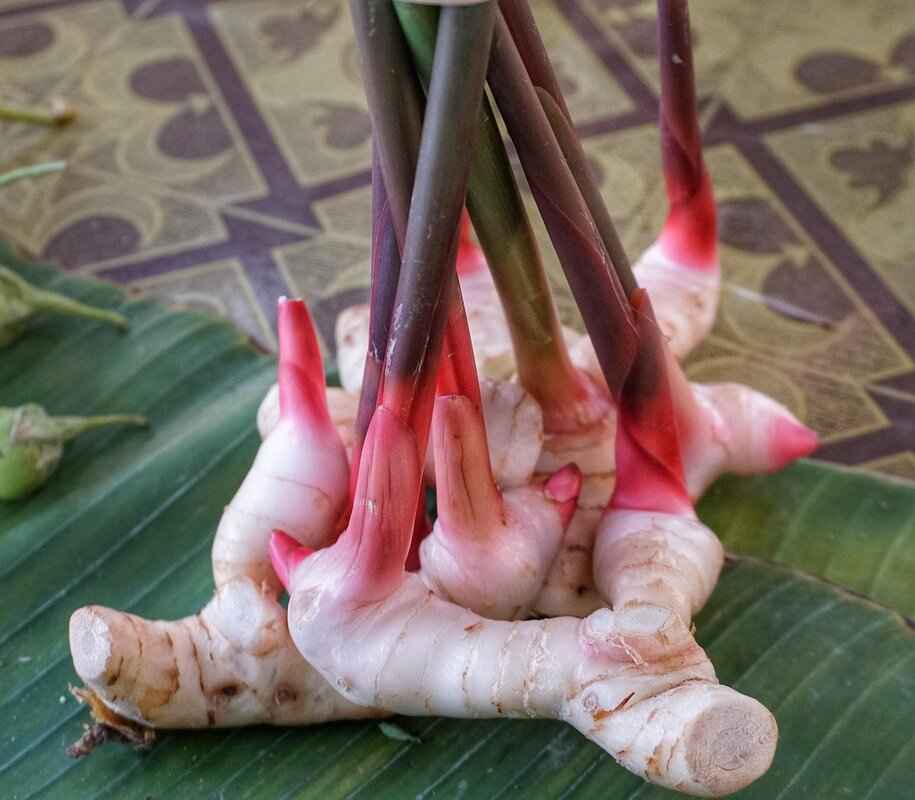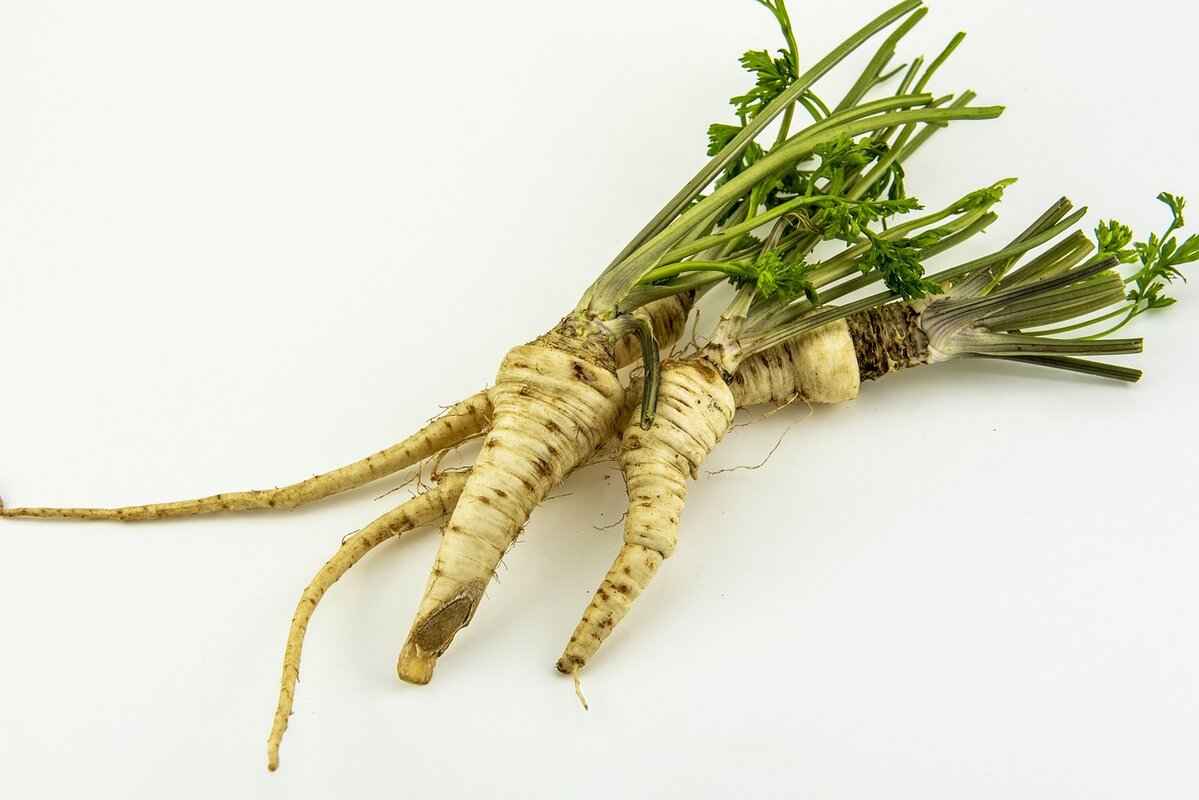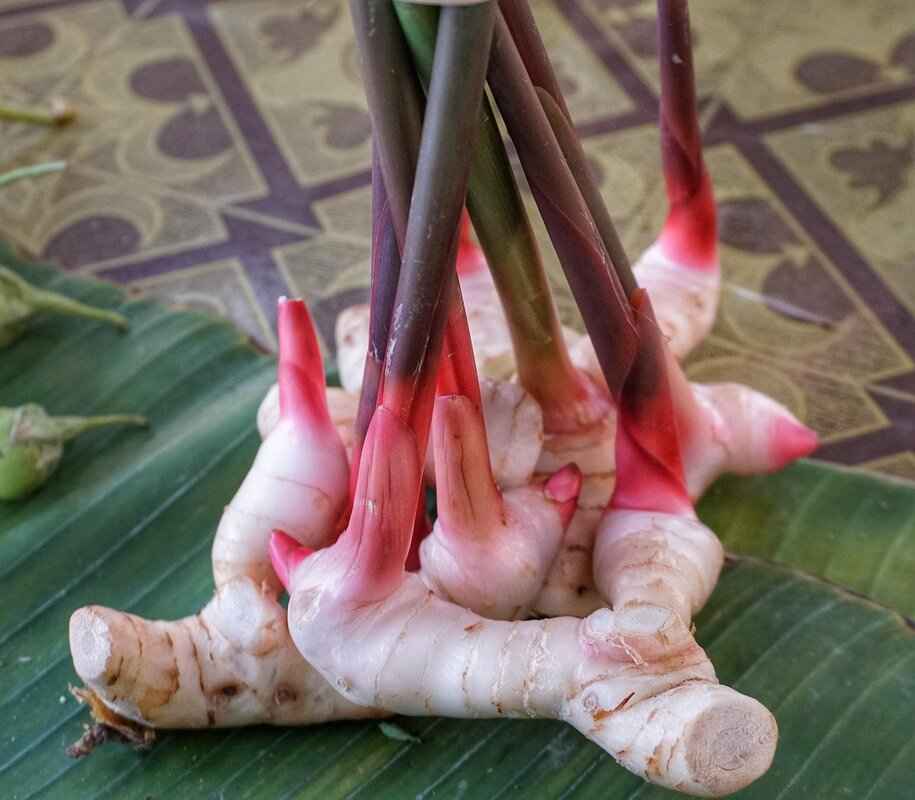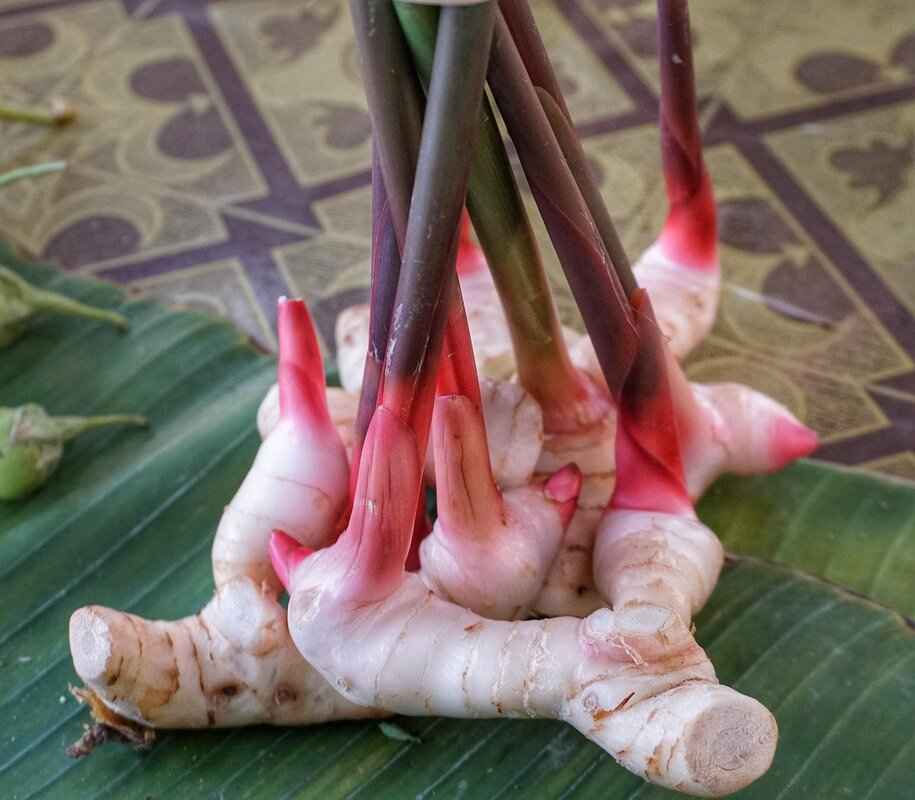Galangal and ginger are two aromatic rhizomes that play a pivotal role in Asian cooking. While they may appear similar at first glance, they possess distinct flavors and culinary applications that set them apart. This article will delve into the unique characteristics of both ingredients, exploring their uses, health benefits, and preparation methods.
Galangal, often referred to as Thai ginger, is a key ingredient in many Southeast Asian dishes. Its flavor is described as sharp, citrusy, and pine-like, making it a wonderful addition to soups, curries, and marinades. Commonly found in Thai cuisine, galangal is used in dishes like Tom Yum soup and Green Curry. It can be used fresh, dried, or powdered, but fresh galangal is preferred for its vibrant flavor.
While both galangal and ginger belong to the same family, they differ significantly in taste and texture. Ginger has a warm, spicy flavor with a hint of sweetness, which makes it versatile in both savory and sweet dishes. It is commonly used in stir-fries, desserts, and beverages like ginger tea. Understanding these differences is crucial for achieving the desired flavor profile in your cooking.
- Galangal’s Unique Taste: Galangal’s flavor is often described as more intense than ginger, with a hint of citrus and a refreshing quality. It pairs well with ingredients like lemongrass and kaffir lime leaves.
- Ginger’s Warm and Spicy Notes: Ginger’s flavor is warm and slightly peppery, providing a comforting element to dishes. It is often used in both savory recipes and sweet treats, adding depth and warmth.
Both ingredients are staples in Asian cuisine, but they serve different purposes. Galangal is often used in traditional dishes such as Laksa and Massaman Curry, where its bold flavor can shine through. On the other hand, ginger is a frequent addition to stir-fried vegetables, marinated meats, and even baked goods like gingerbread cookies.
Both galangal and ginger offer a plethora of health benefits. Galangal is known for its anti-inflammatory properties and is often used in traditional medicine to alleviate digestive issues. It also contains antioxidants that help combat oxidative stress.
Ginger, widely recognized for its digestive benefits, is effective in reducing nausea and improving gut health. It also has anti-inflammatory properties and can help alleviate pain and discomfort.
Proper preparation of both rhizomes ensures that their flavors are maximized in your dishes. To prepare galangal, start by peeling the skin with a knife or vegetable peeler, then slice it thinly or grate it for use in recipes. For ginger, peeling can be done similarly, and it can be sliced, minced, or grated depending on the dish.
To keep galangal and ginger fresh, store them in a cool, dry place. For longer shelf life, consider refrigerating them in a paper bag or wrapping them in a damp cloth. This helps maintain their moisture and flavor.
If you find yourself without galangal or ginger, there are suitable substitutes. For galangal, a combination of ginger and lemon zest can mimic its flavor. For ginger, you can use ground ginger or even a dash of allspice as alternatives.
When galangal is unavailable, using a mix of ginger and a splash of lime juice can replicate its citrusy notes effectively. Alternatively, you can use fresh turmeric for a different yet complementary flavor.
Finding a substitute for ginger is relatively straightforward. Options include ground ginger, galangal, or even a small amount of cardamom for a unique twist in recipes.

What is Galangal and How is it Used?
Galangal, often mistaken for ginger, is a rhizome that plays a pivotal role in various Asian cuisines. With its unique flavor profile, it offers a distinct taste that enhances numerous dishes. This article delves into the intricacies of galangal, exploring its culinary applications, flavor characteristics, and how it can elevate your cooking.
Galangal, belonging to the Zingiberaceae family, is a root similar in appearance to ginger but with a flavor that is entirely its own. It is commonly used in Thai, Indonesian, and Malaysian dishes, where it contributes a sharp, citrusy note that is both refreshing and aromatic.
In culinary applications, galangal is typically used in curries, soups, and stir-fries. Its robust flavor holds up well in cooking, making it ideal for dishes that require longer cooking times. For instance, in Thai cuisine, galangal is a key ingredient in Tom Yum soup, where it adds depth and complexity to the broth.
- Curries: Galangal can be ground into a paste and added to curry dishes, providing a unique flavor that distinguishes them from those made with ginger.
- Soups: It is often sliced and added to soups, imparting a warm, earthy taste that complements other ingredients.
- Stir-fries: When thinly sliced, galangal can be tossed into stir-fries for an aromatic kick.
When using galangal, it is essential to note that its flavor is much more pronounced than that of ginger. Therefore, it should be used judiciously to avoid overpowering other ingredients. It can be found fresh, dried, or in powdered form, with fresh galangal offering the best flavor.
For those unfamiliar with its taste, galangal has a distinctively sharp and peppery flavor, often described as a blend of citrus and pine. This unique taste makes it a versatile ingredient that can enhance both savory and sweet dishes. It pairs well with ingredients such as lemongrass, kaffir lime leaves, and chili peppers, creating a harmonious balance in recipes.
In addition to its culinary uses, galangal is also known for its potential health benefits. Traditionally, it has been used in herbal medicine to aid digestion and reduce inflammation. Incorporating galangal into your diet can provide not only flavor but also wellness advantages.
In summary, galangal is a remarkable ingredient that deserves a place in your kitchen. Whether you are preparing a traditional Asian dish or experimenting with new flavors, understanding how to use galangal effectively can elevate your culinary creations. Its unique flavor profile, combined with its health benefits, makes it a valuable addition to any cook’s repertoire.

How Does Ginger Differ from Galangal?
When it comes to Asian cooking, understanding the differences between ginger and galangal is essential for achieving the desired flavor profiles in your dishes. While both are rhizomes and share some similarities, they have distinct characteristics that set them apart.
Ginger and galangal may look alike at first glance, but their flavors and culinary uses are quite different. Ginger (Zingiber officinale) is widely recognized for its warm, spicy notes, while galangal (Alpinia galanga) offers a sharper, more citrusy flavor. This section explores their unique attributes, helping you choose the right ingredient for your recipes.
- Appearance: Ginger has a brownish, knobby exterior with a pale yellow interior, while galangal boasts a smoother, lighter skin and a more fibrous, white interior.
- Flavor Profile: Ginger is known for its pungent, warming spice, making it a staple in many dishes. In contrast, galangal provides a bright, almost peppery taste that can elevate soups and curries.
- Culinary Uses: Ginger is commonly used in both sweet and savory dishes, from stir-fries to desserts. Galangal, however, is primarily featured in Southeast Asian cuisines, such as Thai and Indonesian, where it enhances the flavors of soups and marinades.
To better understand the differences, let’s delve deeper into their flavor profiles.
Ginger brings warmth and spice to dishes, often used in both fresh and dried forms. Its versatility allows it to complement a variety of ingredients, making it a popular choice in both Asian and Western cuisines. In contrast, galangal is less common outside of Asian recipes but is essential for authentic flavors in dishes like Tom Yum soup and various curry pastes.
Both ginger and galangal serve unique roles in cooking. For example, ginger is a key ingredient in ginger tea, marinades, and baked goods, while galangal is crucial in dishes such as:
- Tom Kha Gai (Thai Coconut Soup)
- Rendang (Indonesian Beef Curry)
- Various Thai curry pastes
Using the right rhizome can significantly impact the dish’s overall flavor, making it vital to choose the appropriate ingredient based on the recipe.
Both ingredients are not only flavorful but also packed with health benefits. Ginger is renowned for its anti-inflammatory properties and is often used to alleviate digestive issues. On the other hand, galangal is celebrated for its antioxidant benefits and is traditionally used in herbal medicine to treat various ailments.
Proper preparation enhances the flavors of both ginger and galangal. To prepare ginger, peel the skin with a spoon or a knife and slice or grate as needed. For galangal, it’s essential to peel it thoroughly due to its tough skin, and then slice it thinly or pound it into a paste for maximum flavor extraction.
If you find yourself without ginger or galangal, there are substitutes that can mimic their flavors. For ginger, consider using fresh turmeric or ground ginger as alternatives. For galangal, a combination of ginger and lime zest can provide a similar flavor profile in a pinch.
Understanding the differences between ginger and galangal not only enhances your cooking but also allows you to explore the rich tapestry of flavors found in Asian cuisine. By recognizing their unique characteristics, you can elevate your dishes and create authentic culinary experiences.
Flavor Profiles of Galangal and Ginger
When it comes to Asian cuisine, understanding the flavor profiles of galangal and ginger is essential for creating authentic dishes. While both ingredients belong to the same family, their distinct tastes contribute uniquely to various recipes.
Galangal, often mistaken for ginger, has a flavor that is both sharp and citrusy. Its taste is often described as a mix of ginger and pepper, with a hint of pine and a slight bitterness. This complex flavor profile makes galangal a vital ingredient in many Southeast Asian dishes, especially in Thai and Indonesian cuisines.
- Brightening Agent: Galangal adds a refreshing brightness to soups and curries, enhancing the overall flavor.
- Texture: Its firm texture means it can be sliced or pounded into a paste, allowing for versatile culinary applications.
Ginger, on the other hand, is known for its warmth and spice. Its flavor is characterized by a sweet and peppery taste, with a slightly pungent aroma. Ginger is commonly used in both savory and sweet dishes, making it incredibly versatile.
- Spicy Kick: The warmth of ginger can elevate the taste of stir-fries and marinades, providing a delightful kick.
- Sweetness: In desserts, ginger adds a subtle sweetness that balances out richer flavors.
The unique flavor profiles of galangal and ginger not only differentiate them but also influence the overall taste of dishes. For instance, using galangal in a Tom Yum soup brings a distinct zing that complements the sour and spicy elements, while ginger in a stir-fried dish adds warmth and depth, enhancing the savory notes.
When cooking, it’s essential to know when to use each ingredient. Galangal is typically used in dishes that require long cooking times, as its flavors develop beautifully over time. In contrast, ginger can be added at various stages of cooking, depending on the desired intensity of flavor.
- Galangal: Best added early in soups and stews for maximum flavor infusion.
- Ginger: Can be used fresh, dried, or pickled, and is often added towards the end of cooking for a more pronounced taste.
In summary, both galangal and ginger offer unique and complex flavor profiles that are essential to Asian cooking. Understanding their characteristics and how to use them effectively can significantly enhance your culinary creations.
Galangal’s Unique Taste
Galangal, a key ingredient in many Asian cuisines, is often overshadowed by its more common counterpart, ginger. However, its distinctive flavor and culinary versatility make it a must-try for anyone looking to elevate their cooking. With a sharp, citrusy profile, galangal brings a unique brightness to dishes that is hard to replicate. This article will explore the intricate taste notes of galangal and how to effectively incorporate it into your culinary repertoire.
Galangal is known for its sharp and aromatic flavor, which is often described as a blend of citrus and earthy notes. Unlike ginger, which has a warm and spicy kick, galangal offers a more refreshing and zesty taste. This distinct flavor can be attributed to its high content of essential oils, which provide its characteristic aroma and taste.
- Citrusy Notes: Galangal has a pronounced citrus flavor, reminiscent of lemon or lime, which can brighten up soups and stews.
- Earthy Undertones: The subtle earthiness of galangal adds depth, making it a perfect complement to rich dishes.
- Spicy Finish: While not as spicy as ginger, galangal carries a mild heat that enhances the overall flavor profile.
Incorporating galangal into your dishes can transform ordinary meals into extraordinary culinary experiences. Here are some effective ways to use galangal:
- Soups and Broths: Galangal is a staple in many Asian soups, particularly in Thai cuisine. It is often used in Tom Yum soup, where its flavors meld beautifully with lemongrass and kaffir lime leaves.
- Curry Pastes: Fresh galangal is a key ingredient in many curry pastes, lending a unique flavor that cannot be substituted easily.
- Marinades: Adding galangal to marinades for meats or seafood can infuse them with a refreshing zest.
When using galangal, you may encounter both fresh and dried forms. Each has its own unique benefits:
| Type | Flavor Profile | Best Uses |
|---|---|---|
| Fresh Galangal | Bright and aromatic | Soups, curries, salads |
| Dried Galangal | Concentrated and earthy | Slow-cooked dishes, stews |
To maximize the flavor of galangal, proper preparation is essential. Here are some tips:
- Peeling: Use a spoon to scrape off the skin, as it can be tough and fibrous.
- Slicing: Cut galangal into thin slices or small pieces to release its essential oils and flavor.
- Storing: Keep fresh galangal in the refrigerator wrapped in a damp paper towel to maintain its moisture and flavor.
By understanding the unique taste of galangal and how to use it effectively, you can enhance your dishes with its vibrant and refreshing notes. Whether you’re making a traditional Thai curry or experimenting with new recipes, galangal is sure to add a delightful twist to your culinary creations.
Ginger’s Warm and Spicy Notes
Ginger is a remarkable spice that has been cherished in kitchens around the world for centuries. Known for its warmth and spiciness, ginger adds a unique flavor profile that enhances both sweet and savory dishes. This section will delve into the nuances of ginger’s flavor and explore the best methods to incorporate it into your recipes.
The flavor of ginger is often described as zesty and peppery, with hints of sweetness and a touch of citrus. This complex flavor profile makes it a versatile ingredient in various culinary traditions. From Asian stir-fries to Western baked goods, ginger can elevate the taste of any dish.
Incorporating ginger into your recipes can be done in several ways. Here are some popular methods:
- Fresh Ginger: Peel and slice or grate fresh ginger to use in marinades, stir-fries, and dressings.
- Dried Ginger: Ground ginger is perfect for baking and can be added to spice blends.
- Ginger Juice: Extract juice from fresh ginger for a concentrated flavor in beverages and sauces.
Ginger shines in many recipes. Here are a few ideas:
- Ginger Tea: Steep fresh ginger slices in hot water for a soothing drink.
- Ginger Chicken: Marinate chicken with ginger, garlic, and soy sauce for a flavorful dish.
- Ginger Cookies: Use ground ginger in cookie recipes for a warm and spicy treat.
Beyond its culinary uses, ginger is also known for its numerous health benefits. It is often used to aid digestion, combat nausea, and reduce inflammation. Including ginger in your diet can promote overall wellness and enhance your cooking experience.
To maximize the flavor of ginger in your dishes, consider the following tips:
- Freshness Matters: Always use fresh ginger for the best flavor; dried ginger can be more potent but lacks the vibrant taste.
- Pairing Flavors: Ginger pairs beautifully with garlic, citrus, and soy sauce, enhancing the overall profile of your dishes.
- Storage: Store fresh ginger in the refrigerator to maintain its potency, and consider freezing it for long-term use.
In summary, ginger’s warm and spicy notes make it an essential ingredient in various cuisines. By understanding its flavor nuances and employing effective culinary techniques, you can enrich your dishes and enjoy the numerous health benefits it offers. Whether you’re brewing a comforting tea or creating a flavorful stir-fry, ginger is sure to bring a delightful kick to your culinary creations.
Common Culinary Uses
When it comes to Asian cuisine, galangal and ginger are two essential ingredients that play pivotal roles in flavor enhancement. While they may appear similar at first glance, their culinary applications are distinct and vital for achieving authentic taste profiles in popular dishes.
Galangal is commonly used in Southeast Asian dishes, particularly in Thai and Indonesian cuisines. Its sharp, citrusy flavor makes it a perfect addition to:
- Tom Yum Soup: This iconic Thai soup benefits from galangal’s distinct taste, which complements the spiciness and sourness of the dish.
- Rendang: A traditional Indonesian beef stew, where galangal enhances the rich and complex flavors of the coconut milk and spices.
- Curries: Many curry recipes include galangal to provide a refreshing zing that balances the heat of chili peppers.
Ginger is a versatile ingredient found in numerous Asian dishes, known for its warm and spicy notes. It is often used in:
- Stir-fries: Ginger adds depth and warmth to vegetable and meat stir-fries, enhancing the overall flavor profile.
- Marinades: Its natural spiciness makes it an excellent component in marinades for meats, helping to tenderize and infuse flavor.
- Teas and Soups: Ginger is frequently steeped in teas or added to soups for its soothing properties and aromatic qualities.
While both ingredients enhance flavors, they do so in different ways. Galangal’s flavor is often described as more intense and citrusy compared to ginger’s warm and slightly sweet profile. This makes each ingredient suitable for specific culinary contexts. For instance, galangal’s brightness is ideal for soups and broths, while ginger’s warmth shines in stir-fries and marinades.
In some recipes, both galangal and ginger can be used together to create a complex flavor profile. A great example is:
- Thai Green Curry: This dish often combines both ingredients, allowing their unique flavors to meld and enhance the overall taste experience.
To maximize the flavor of galangal and ginger, consider these tips:
- Fresh is Best: Always use fresh galangal and ginger for the most potent flavors. Dried or powdered forms lack the vibrant taste of their fresh counterparts.
- Proper Preparation: For galangal, peel and slice thinly to release its essential oils. For ginger, peeling with a spoon can be effective, and slicing or grating will help distribute its flavor evenly.
- Timing in Cooking: Add galangal early in the cooking process to allow its flavor to infuse, while ginger can be added later for a more pronounced taste.
In summary, both galangal and ginger serve unique and essential roles in Asian cooking. Understanding their distinct flavors and culinary uses can elevate your dishes, providing a rich and authentic taste experience. Whether you’re crafting a spicy curry or a soothing soup, these ingredients are invaluable for flavor enhancement.

Health Benefits of Galangal and Ginger
When it comes to enhancing both flavor and health, galangal and ginger are two powerhouse ingredients in Asian cuisine. Their medicinal properties and nutritional values have been recognized for centuries, making them staples in traditional and modern cooking alike. This section will delve into the numerous health benefits these rhizomes offer, their unique contributions to overall wellness, and how they can be incorporated into your diet.
Galangal, often mistaken for ginger, boasts a plethora of health benefits that make it a valuable addition to any diet. Its active compounds, such as galangin and alpha-pinene, provide potent anti-inflammatory and antioxidant properties. These compounds help combat oxidative stress in the body, potentially reducing the risk of chronic diseases.
- Digestive Health: Galangal has been traditionally used to alleviate digestive issues. It can help stimulate appetite and reduce bloating.
- Anti-Inflammatory Effects: The anti-inflammatory properties of galangal can assist in reducing pain associated with conditions like arthritis.
- Immune Support: By enhancing the immune system, galangal may help the body fight off infections more effectively.
Ginger is perhaps one of the most well-known spices in the world, celebrated not just for its flavor but also for its numerous health benefits. Rich in gingerol, ginger’s active compound is known for its powerful medicinal properties.
- Digestive Aid: Ginger is widely recognized for its ability to alleviate nausea and improve digestion. It is particularly beneficial for individuals experiencing motion sickness or morning sickness during pregnancy.
- Anti-Nausea Properties: Studies have shown that ginger can effectively reduce nausea and vomiting, making it a popular remedy for chemotherapy patients.
- Anti-Inflammatory Benefits: Similar to galangal, ginger also has anti-inflammatory properties that can help with pain relief, especially for muscle soreness and arthritis.
Both galangal and ginger are more than just culinary ingredients; they play a significant role in promoting overall wellness. Their rich antioxidant content helps protect the body from free radicals, which can lead to various health issues. Incorporating these rhizomes into your daily diet can provide a natural boost to your immune system and enhance your body’s ability to fight off diseases.
Moreover, the anti-inflammatory properties of both ingredients can assist in managing chronic conditions, including heart disease and diabetes. Their ability to improve digestion also contributes to better nutrient absorption, leading to improved energy levels and overall vitality.
Adding galangal and ginger to your meals is simple and can be done in various ways. You can use fresh rhizomes in stir-fries, soups, and marinades or opt for powdered forms in baking and spice blends. Herbal teas made from ginger or galangal can also serve as soothing beverages that offer health benefits.
In conclusion, the health benefits of galangal and ginger are extensive, making them invaluable ingredients in both culinary and medicinal practices. By understanding their unique properties and how to incorporate them into your diet, you can enhance not only the flavor of your dishes but also your overall health and well-being.
Galangal’s Medicinal Properties
Galangal, a rhizome that belongs to the ginger family, has garnered attention not just for its culinary applications but also for its remarkable medicinal properties. Traditionally used in various cultures, especially in Asian herbal medicine, galangal is celebrated for its rich array of health benefits.
One of the most notable aspects of galangal is its anti-inflammatory properties. Chronic inflammation is linked to numerous health issues, including heart disease and arthritis. Galangal contains compounds that can help reduce inflammation, making it a valuable addition to a health-conscious diet.
In addition to its anti-inflammatory effects, galangal is rich in antioxidants. Antioxidants are crucial for neutralizing free radicals in the body, which can lead to cellular damage and aging. Regular consumption of galangal may contribute to improved overall health by protecting cells from oxidative stress.
- Digestive Health: Galangal has been used to alleviate digestive issues such as bloating and nausea. Its compounds can stimulate digestive enzymes, promoting better digestion.
- Respiratory Support: Traditionally, galangal has been employed to relieve respiratory conditions. Its anti-inflammatory properties can help soothe sore throats and reduce congestion.
- Antimicrobial Effects: Some studies suggest that galangal may have antimicrobial properties, making it beneficial in fighting off infections.
Incorporating galangal into your meals can be both delicious and beneficial for your health. It can be used in soups, stir-fries, and marinades. Fresh galangal is often preferred, but dried or powdered forms are also widely available.
While galangal is generally safe for most people, it is important to consume it in moderation. Some individuals may experience allergic reactions or gastrointestinal discomfort. It is advisable to consult with a healthcare provider before adding significant amounts of galangal to your diet, especially for those with existing health conditions or who are pregnant.
In conclusion, the medicinal properties of galangal extend beyond its culinary uses. With its anti-inflammatory and antioxidant benefits, along with its traditional applications in herbal medicine, galangal is a versatile ingredient that can enhance both flavor and health. By understanding its benefits and incorporating it wisely into your diet, you can enjoy the numerous advantages this remarkable rhizome has to offer.
Ginger’s Health Advantages
Ginger, a well-known spice, has been a staple in traditional medicine for centuries, celebrated for its numerous health benefits. This section delves into the remarkable advantages of ginger, particularly its role in promoting digestive health and alleviating nausea, while also exploring how to seamlessly incorporate it into a balanced diet.
One of the most notable benefits of ginger is its ability to enhance digestion. Ginger contains bioactive compounds such as gingerol and shogaol, which have been shown to stimulate saliva, bile, and gastric enzymes. These compounds help in breaking down food more efficiently, leading to improved nutrient absorption.
Ginger is widely recognized for its effectiveness in reducing nausea, particularly in pregnant women experiencing morning sickness and individuals undergoing chemotherapy. Studies suggest that ginger can help reduce nausea by acting on the gastrointestinal tract and the central nervous system, making it a natural remedy for those suffering from motion sickness as well.
Integrating ginger into your meals is not only beneficial for health but also adds a delightful flavor. Here are some practical ways to include ginger in your diet:
- Fresh Ginger Tea: Brew fresh ginger slices in hot water for a soothing tea that aids digestion and calms nausea.
- Ginger in Smoothies: Add a small piece of ginger to your morning smoothie for an invigorating start to the day.
- Stir-fries and Curries: Use minced ginger in stir-fries or curries to enhance flavor while reaping its health benefits.
- Baking: Incorporate ground ginger into baked goods like cookies and cakes for a spicy kick.
Ginger is low in calories yet packed with essential nutrients. It is a rich source of antioxidants and contains vitamins such as Vitamin C and Vitamin B6, along with minerals like magnesium and potassium. This nutritional profile contributes to ginger’s anti-inflammatory properties, making it beneficial for overall health.
While ginger is generally safe for most people, it is essential to consume it in moderation. Excessive intake may lead to digestive issues such as heartburn or diarrhea. Individuals on blood thinners or those with certain medical conditions should consult with a healthcare provider before significantly increasing their ginger consumption.
Incorporating ginger into your diet can be a flavorful and healthful choice. With its impressive array of benefits, from aiding digestion to alleviating nausea, ginger stands out as a powerful ally in promoting wellness. By exploring various culinary uses and understanding its health advantages, you can enjoy the full spectrum of what ginger has to offer.

How to Prepare Galangal and Ginger for Cooking
Proper preparation of galangal and ginger is essential for maximizing their flavors and enhancing your culinary creations. These two rhizomes are staples in Asian cooking, known for their unique taste and health benefits. In this section, we will explore practical tips on how to peel, slice, and store these ingredients to ensure you get the best out of them.
Why is Proper Preparation Important?
Both galangal and ginger have distinct flavors that can significantly impact the outcome of your dishes. Proper preparation not only helps in releasing their essential oils but also enhances their aromatic qualities. Here are some effective methods for preparing these rhizomes.
Peeling Techniques for Galangal and Ginger
- Galangal: Use a vegetable peeler or the edge of a spoon to gently scrape away the skin. The skin can be tough, so it’s important to apply some pressure without damaging the flesh.
- Ginger: Similar to galangal, ginger can be peeled with a vegetable peeler, but for more intricate areas, a spoon works wonders. This method helps you navigate around the knobbly parts without wasting too much of the rhizome.
Slicing Techniques for Optimal Flavor Release
Once peeled, the way you slice these rhizomes can affect their flavor intensity:
- Galangal: For a milder flavor, slice thinly; for a stronger taste, use thicker slices or even crush the galangal to release more oils. It’s often added to soups and curries where it can infuse its flavor.
- Ginger: Ginger can be sliced, julienned, or grated depending on the dish. Grating releases the most flavor, making it ideal for marinades and dressings, while slices work well in stir-fries.
Storing Galangal and Ginger for Freshness
To maintain the freshness and flavor of galangal and ginger, proper storage is crucial:
- Refrigeration: Store fresh galangal and ginger in a paper bag or wrapped in a damp cloth inside the refrigerator. This helps maintain moisture without causing mold.
- Freezing: For longer storage, consider freezing. Peel and slice them first, then place in an airtight container or freezer bag. They can be used directly from the freezer in cooking.
Using Galangal and Ginger in Cooking
After preparing these ingredients, incorporating them into your dishes is the next step. Galangal is often used in soups, curries, and stir-fries, while ginger is versatile, enhancing everything from teas to marinades. Their unique flavors can transform a simple dish into an aromatic experience.
In conclusion, understanding the proper preparation methods for galangal and ginger can significantly enhance your cooking. By peeling, slicing, and storing these rhizomes correctly, you can maximize their flavors and health benefits, ensuring that your dishes are not only delicious but also vibrant and aromatic.
Peeling and Slicing Techniques
When it comes to enhancing your culinary skills, mastering the art of peeling and slicing galangal and ginger is essential. These two rhizomes are staples in Asian cooking, known for their unique flavors and health benefits. Understanding the correct techniques not only improves the texture and presentation of your dishes but also maximizes the flavors they impart. Here’s a detailed guide to help you peel and slice these ingredients effectively.
Properly preparing galangal and ginger allows their essential oils and flavors to be released, enhancing the overall taste of your meals. Incorrect techniques can lead to a loss of flavor and nutrients, impacting the quality of your dish.
- Choose Fresh Galangal: Start with a firm, unblemished piece of galangal. Freshness is key to achieving the best flavor.
- Wash Thoroughly: Rinse the rhizome under cold water to remove any dirt or debris.
- Use a Peeler or Knife: Using a vegetable peeler or a sharp knife, gently peel away the outer skin. Be careful to remove only the skin, avoiding too much of the flesh underneath.
- Cut into Slices: Once peeled, slice the galangal into thin rounds or julienne strips, depending on your recipe requirements.
- Select Quality Ginger: Look for ginger that is firm and smooth. Avoid any that is shriveled or has dark spots.
- Wash the Ginger: Rinse under running water to clean off any dirt.
- Peeling Techniques: You can use a spoon to scrape off the skin, which is effective and minimizes waste. Alternatively, a vegetable peeler works well for larger pieces.
- Slicing Ginger: After peeling, slice the ginger into thin pieces or matchsticks. For a finer texture, you can also grate it using a microplane.
When slicing both galangal and ginger, aim for uniform thickness to ensure even cooking. A sharp knife is crucial for clean cuts, which helps in releasing the flavors effectively. If you’re preparing a dish that requires a strong ginger flavor, consider slicing it thinner to enhance its potency.
After peeling and slicing, store your galangal and ginger properly to maintain their freshness. Place them in an airtight container in the refrigerator, where they can last for up to a week. For longer storage, consider freezing them. Just ensure they are in a freezer-safe bag, and they can last for several months without losing flavor.
By mastering these peeling and slicing techniques, you’ll not only enhance your cooking experience but also elevate the flavors of your Asian dishes. The right preparation can make a significant difference in your culinary creations, allowing the natural aromas and tastes of galangal and ginger to shine through.
Storage Tips for Freshness
When it comes to ensuring the longevity of your galangal and ginger, proper storage techniques can make all the difference. These aromatic rhizomes are not only essential for flavoring a variety of dishes but also boast numerous health benefits. Here, we delve into the best practices for storing these ingredients to keep them fresh and potent for as long as possible.
Both galangal and ginger are highly perishable. Improper storage can lead to spoilage, loss of flavor, and a decrease in nutritional value. Understanding the right conditions for storage can help you maximize their shelf life and maintain their quality.
- Keep it Cool: Store fresh galangal in the refrigerator. Ideally, it should be placed in a perforated plastic bag to allow airflow while preventing moisture accumulation.
- Dry and Dark: If you have dried galangal, keep it in an airtight container in a cool, dark place. This will help preserve its flavor and prevent it from becoming stale.
- Freezing for Longevity: For long-term storage, consider freezing galangal. Peel and slice it before placing it in an airtight container or freezer bag. This way, you can easily use it in your recipes without thawing the entire batch.
- Refrigeration: Similar to galangal, fresh ginger should be stored in the refrigerator. Wrap it in a paper towel and place it in a resealable plastic bag to absorb excess moisture.
- Using a Jar: Another effective method is to place ginger in a jar filled with dry sand or rice. This can help keep it fresh for weeks.
- Freezing Ginger: Ginger can also be frozen. Peel and chop it, then store it in an airtight container. This method retains its flavor and makes it convenient for future use.
It’s essential to recognize when galangal and ginger have gone bad. Look for the following signs:
- Softness: If either rhizome feels mushy or soft, it’s a sign of spoilage.
- Discoloration: Any dark spots or a change in color indicates that the rhizome is no longer fresh.
- Unpleasant Odor: A sour or off smell is a clear indication that the ingredient should be discarded.
By following these storage tips, you can significantly extend the shelf life of your galangal and ginger. Proper storage not only helps maintain their flavor and nutritional benefits but also ensures that you have these essential ingredients on hand whenever you need them for your cooking adventures.

Substituting Galangal and Ginger in Recipes
When cooking Asian dishes, galangal and ginger are often essential ingredients. However, there may be times when you find yourself without these flavorful rhizomes. Understanding how to effectively substitute them is crucial for maintaining the integrity of your recipes. This section will explore various alternatives to galangal and ginger, along with tips on how to use them to achieve similar flavor profiles.
Both galangal and ginger serve unique purposes in cooking, but their distinct flavors can sometimes be difficult to replicate. Knowing how to substitute them allows you to continue preparing your favorite dishes without compromising on taste.
If you don’t have galangal on hand, there are several alternatives you can use:
- Ginger: While it has a different flavor profile, fresh ginger can serve as a suitable substitute in many dishes. Use about half the amount of ginger as you would galangal, as its flavor is more intense.
- Lemongrass: This herb offers a bright, citrusy flavor similar to galangal. Use the tender part of the stalk, finely chopped, as a substitute in soups and curries.
- Turmeric: Though it has a more earthy flavor, turmeric can provide a warm color and health benefits. Use it sparingly to replace galangal, especially in curries.
- Allspice: This spice can mimic the warm, aromatic notes of galangal. Use it in small quantities to avoid overpowering your dish.
When ginger is missing from your kitchen, consider these alternatives:
- Galangal: If you have galangal available, it can be a direct substitute for ginger, keeping in mind the flavor differences.
- Ground Ginger: If you have dried ginger powder, it can be used in a pinch. Use about one-fourth of the amount of fresh ginger called for in the recipe.
- Cardamom: This spice offers a unique flavor that can enhance your dish. Use it sparingly, as it can easily dominate the flavor profile.
- Garlic: In certain recipes, garlic can add warmth and depth, although it will not replicate the exact taste of ginger. Use it in moderation to complement other flavors.
When substituting galangal or ginger, consider the overall flavor profile of your dish. Start with a smaller amount of the substitute, and gradually increase it to achieve the desired flavor. Additionally, think about the cooking method; for instance, fresh substitutes may work better in soups, while dried options may be more suitable for marinades or spice blends.
Lastly, remember that while substitutes can mimic flavors, they may not replicate the exact taste and aroma of galangal and ginger. Experimentation is key, so don’t hesitate to adjust your ingredients based on your personal preferences and the specific dish you are preparing.
Best Substitutes for Galangal
When you find yourself in the kitchen ready to whip up a delicious Asian dish, but galangal is nowhere to be found, don’t worry! There are several effective substitutes that can mimic its unique flavor profile. Understanding these alternatives can help you maintain the integrity of your recipes without compromising taste.
Galangal is a rhizome that belongs to the ginger family, known for its sharp, citrusy flavor and distinct aroma. It is a staple in many Southeast Asian cuisines, particularly in Thai and Indonesian dishes. Its flavor is often described as a combination of ginger and pepper, with a hint of pine. However, when galangal is unavailable, here are some substitutes that can work wonders in your cooking.
- Ginger: The most common substitute for galangal is ginger. While it lacks the citrus notes of galangal, it offers a warm and spicy flavor that can complement many dishes. Use fresh ginger in a 1:1 ratio as a direct substitute.
- Thai Ginger (Kencur): If you can find it, Thai ginger, or kencur, is a closer match to galangal’s flavor. It has a similar aromatic quality and can be used in the same proportions as galangal.
- Lemongrass: Lemongrass can also serve as a substitute, especially in soups and curries. It adds a fresh, citrusy flavor that can help replicate the brightness that galangal provides. Use it in combination with ginger for best results.
- Turmeric: While turmeric has a different flavor, it can provide an earthy base and a vibrant color to your dishes. Use it sparingly, as its taste is quite distinct.
- Garlic and Lime Zest: For recipes where galangal is used for its aromatic qualities, a combination of garlic and lime zest can mimic the flavor profile. Use minced garlic and a small amount of lime zest to achieve a similar effect.
When substituting galangal, it’s essential to consider the overall flavor profile of your dish. Here are some tips:
- Adjust Quantities: Start with a smaller amount of the substitute and taste as you go. This ensures that the new flavor complements rather than overwhelms your dish.
- Combine Flavors: Sometimes, using a combination of substitutes can yield a more balanced flavor. For instance, pairing ginger with lemongrass can help replicate the complexity of galangal.
- Fresh vs. Dried: Always opt for fresh substitutes when possible, as they provide a more vibrant flavor compared to dried options.
By understanding these alternatives and how to use them, you can ensure that your Asian dishes remain flavorful and authentic, even in the absence of galangal. So next time you’re missing this key ingredient, reach for these substitutes and keep cooking!
Ginger Substitutes: What Works?
When you find yourself in the kitchen without ginger, it can be a bit daunting. However, there are several effective substitutes that can help you achieve similar flavor profiles in your dishes. Understanding what works as a replacement for ginger is essential for maintaining the integrity of your recipes.
Ginger is renowned for its warm and spicy flavor, often used in both sweet and savory dishes. However, various reasons may lead you to seek alternatives, such as allergies, dietary restrictions, or simply running out of the ingredient. Knowing how to substitute ginger can ensure that your dish remains flavorful and satisfying.
- Galangal: Often confused with ginger, galangal has a sharper, more citrusy flavor. It works well in Asian dishes where ginger is typically used. Use it in equal amounts as a direct substitute.
- Ground Ginger: If you have ground ginger on hand, it can be an excellent alternative. Use 1/4 teaspoon of ground ginger for every tablespoon of fresh ginger required. Keep in mind that ground ginger is more concentrated, so adjust accordingly.
- Fresh Turmeric: Known for its vibrant color and health benefits, fresh turmeric can add warmth and earthiness to your dishes. Use it in a 1:1 ratio as a ginger substitute, but be aware that it will impart a different flavor.
- Cardamom: This spice has a unique flavor profile that can mimic the warmth of ginger. Use crushed cardamom pods or ground cardamom in smaller quantities, as it has a more potent flavor. Start with 1/4 teaspoon and adjust to taste.
- Garlic: While not a direct flavor match, garlic can add depth and warmth to a dish. It works particularly well in savory recipes. Use minced garlic in a 1:1 ratio, but consider the overall flavor profile of your dish.
- Cinnamon: For sweet dishes, cinnamon can provide a warm and aromatic substitute for ginger. Use it sparingly, starting with 1/4 teaspoon, and adjust as needed.
When substituting ginger, it’s important to consider the overall flavor balance of your dish. Here are some tips:
- Start Small: Begin with a smaller amount of the substitute and gradually increase it to avoid overpowering the dish.
- Taste as You Go: Always taste your dish as you add substitutes to ensure the flavors meld well.
- Consider the Dish Type: Some substitutes work better in specific types of dishes. For example, galangal is great in soups and stir-fries, while cinnamon is better suited for baked goods.
Finding a suitable substitute for ginger can be straightforward with the right knowledge. Whether you opt for galangal, ground ginger, or other spices, each alternative brings its unique flavor to your dishes. By understanding how to use these substitutes properly, you can maintain the deliciousness of your recipes without compromising on taste.
Frequently Asked Questions
- What is the main difference between galangal and ginger?
Galangal has a sharper, more citrusy flavor compared to ginger, which is warm and spicy. They also differ in appearance, with galangal being more knobby and having a pale pinkish hue.
- Can I use ginger instead of galangal in recipes?
Yes, you can substitute ginger for galangal, but keep in mind that the flavor will change. Ginger is spicier and less citrusy, so it may not provide the same brightness in dishes.
- How should I store fresh galangal and ginger?
To keep them fresh longer, store galangal and ginger in a cool, dry place. You can also wrap them in a paper towel and place them in a plastic bag in the fridge for extended freshness.
- What are the health benefits of galangal and ginger?
Both galangal and ginger have anti-inflammatory properties. Galangal is known for its antioxidant benefits, while ginger is widely recognized for aiding digestion and reducing nausea.
- What are some common dishes that use galangal or ginger?
Galangal is often used in Thai soups and curries, while ginger is a staple in various Asian stir-fries, teas, and desserts, adding depth and warmth to the flavors.














